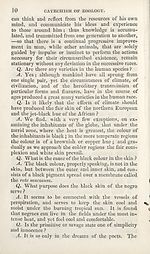Download files
Complete book:
Individual page:
Thumbnail gallery: Grid view | List view

CATECHISM OF ZOOLOGV. 1 ]
savage state is, on the contrary, the lowest grade of
human existence. The passions are gross and unre¬
strained, the mind superstitious and credulous, im¬
provident of the present and thinking nothing of the
future. It is only when illumined by the light of
knowledge, and the refinement of civilization, that
man asserts his true dignity of lord of the creation.
Q. How many varieties are there in the human race ?
A. Almost every tribe and nation present some
marked peculiarities of features or form, so that it is
not easy to arrange mankind into definite varieties.
Llumenbach has enumerated five different kinds.
Q. What are they ?
A. The Caucasian, the Mongolian, the Ethiopian,
the American, the Malay.
Q. Describe the Caucasian variety.
A. The Caucasian variety is so called, from the
country around Mount Caucasus being supposed to
be the abode of the first race of mankind. The Geor¬
gians and Circassians are the most perfect specimens
of this variety, and it includes every different shade of
the white race. The head is large, and the forehead
expanded; the features symmetrical; the hair and eyes
of various shades of colour. All the European nations,
except the Laplanders, are of this variety, and it in¬
cludes that portion of mankind most eminent for re¬
finement, civilization, and the exercise of mental talents
and ingenuity.
Q. What is the description of the Mongolian race ?
A. The Mongolian variety, or Moguls, is a nume¬
rous tribe inhabiting Central and Northern Asia, and
includes the Calmucks, Chinese, and Japanese, the
inhabitants of Thibet, Ava, and Siam, the Laplanders,
and the Esquimaux. They are of a yellow colour,
something like dried lemon-peel, have black eyes,
black straight thin hair, little beard, square head,
with low and narrow forehead, and broad flat face,
round projecting cheeks, thick lips, and eyes placed
obliquely.
Q. What is the next variety ?
savage state is, on the contrary, the lowest grade of
human existence. The passions are gross and unre¬
strained, the mind superstitious and credulous, im¬
provident of the present and thinking nothing of the
future. It is only when illumined by the light of
knowledge, and the refinement of civilization, that
man asserts his true dignity of lord of the creation.
Q. How many varieties are there in the human race ?
A. Almost every tribe and nation present some
marked peculiarities of features or form, so that it is
not easy to arrange mankind into definite varieties.
Llumenbach has enumerated five different kinds.
Q. What are they ?
A. The Caucasian, the Mongolian, the Ethiopian,
the American, the Malay.
Q. Describe the Caucasian variety.
A. The Caucasian variety is so called, from the
country around Mount Caucasus being supposed to
be the abode of the first race of mankind. The Geor¬
gians and Circassians are the most perfect specimens
of this variety, and it includes every different shade of
the white race. The head is large, and the forehead
expanded; the features symmetrical; the hair and eyes
of various shades of colour. All the European nations,
except the Laplanders, are of this variety, and it in¬
cludes that portion of mankind most eminent for re¬
finement, civilization, and the exercise of mental talents
and ingenuity.
Q. What is the description of the Mongolian race ?
A. The Mongolian variety, or Moguls, is a nume¬
rous tribe inhabiting Central and Northern Asia, and
includes the Calmucks, Chinese, and Japanese, the
inhabitants of Thibet, Ava, and Siam, the Laplanders,
and the Esquimaux. They are of a yellow colour,
something like dried lemon-peel, have black eyes,
black straight thin hair, little beard, square head,
with low and narrow forehead, and broad flat face,
round projecting cheeks, thick lips, and eyes placed
obliquely.
Q. What is the next variety ?
Set display mode to:
![]() Universal Viewer |
Universal Viewer | ![]() Mirador |
Large image | Transcription
Mirador |
Large image | Transcription
| Antiquarian books of Scotland > Curiosities & wonders > Catechism of zoology, or, Natural history of the animal kingdom > (17) |
|---|
| Permanent URL | https://digital.nls.uk/113571058 |
|---|
| Description | Thousands of printed books from the Antiquarian Books of Scotland collection which dates from 1641 to the 1980s. The collection consists of 14,800 books which were published in Scotland or have a Scottish connection, e.g. through the author, printer or owner. Subjects covered include sport, education, diseases, adventure, occupations, Jacobites, politics and religion. Among the 29 languages represented are English, Gaelic, Italian, French, Russian and Swedish. |
|---|

